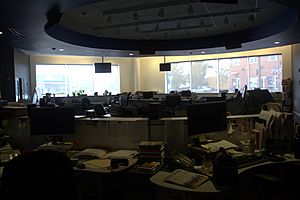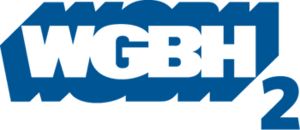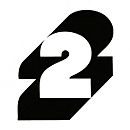WGBH-TV facts for kids
 |
|
| Boston, Massachusetts United States |
|
|---|---|
| Channels | Digital: 5 (VHF) (shared with WFXZ-CD) Virtual: 2 |
| Branding | GBH 2 |
| Programming | |
| Affiliations | 2.1/44.1: PBS |
| Ownership | |
| Owner | WGBH Educational Foundation |
|
Sister stations
|
|
| History | |
|
First air date
|
May 2, 1955 |
|
Former channel number(s)
|
|
|
Former affiliations
|
NET (1955–1970) |
|
Call sign meaning
|
Great Blue Hill (original location of transmitter) |
| Technical information | |
|
Licensing authority
|
FCC |
| Facility ID | 72099 |
| ERP | 34 kW |
| HAAT | 362.7 m (1,190 ft) |
| Transmitter coordinates | 42°18′10.7″N 71°13′4.9″W / 42.302972°N 71.218028°W |
| Links | |
|
Public license information
|
Profile LMS |
WGBH-TV, known as GBH or GBH 2, is a Public Broadcasting Service (PBS) television station in Boston, Massachusetts. It's the main station of the WGBH Educational Foundation. This foundation also owns other stations like WGBX-TV (channel 44) and WGBY-TV (channel 57) in Springfield. They also own radio stations WGBH (89.7 FM) and WCRB (99.5 FM) in Boston. WGBH-TV is one of the main PBS stations in the U.S., along with WNET in New York City and WETA-TV in Washington, D.C.
WGBH-TV, WGBX-TV, and the WGBH and WCRB radio stations share studios in the Brighton area of Boston. WGBH-TV's transmitter is located in Needham, Massachusetts. This transmitter tower is also used by other major TV stations in the Boston area.
Contents
The Story of GBH: How It Started
The WGBH Educational Foundation first got a license for radio in April 1951. This was thanks to a group of local universities and cultural places called the Lowell Institute Cooperative Broadcasting Council. This group was formed because of a gift from John Lowell, Jr. in 1836, which asked for free public talks for Boston citizens. The radio station, WGBH, started broadcasting on October 6, 1951. Its first show was a live concert by the Boston Symphony Orchestra.
The Federal Communications Commission (FCC) first allowed an electronics company called Raytheon to build a TV station in Boston. This station would have been on channel 2. Raytheon planned to call it WRTB-TV. But their plans didn't work out, so the FCC decided that channel 2 should be used for educational programs instead. WGBH then applied for and received the license for this channel. They got money to start WGBH-TV from the Lincoln and Therese Filene Foundation.
WGBH-TV first went on air on May 2, 1955, at 5:20 p.m. It was the first public television station in Boston and in New England. The very first show was Come and See, a children's program. For its first few years, channel 2 only broadcast on weekdays from 5:30 to 9:00 p.m.
For the first six years, the station worked from studios in Cambridge, Massachusetts. These studios were in a building that used to be a roller skating rink! The bumpy floors made it hard to move the heavy TV cameras, and loud creaking noises were a problem for the sound engineers.
The station's call letters, WGBH, refer to Great Blue Hill. This is the highest point in the Boston area and was where WGBH-TV's first transmitter was located. The radio station's transmitter is still there today.
In 1957, Hartford N. Gunn Jr. became the general manager of WGBH. He helped the station grow a lot. Under his leadership, WGBH invested in new technology and shows. They wanted to become a major producer of public television programs. In February 1970, WGBH started broadcasting on weekends for the first time. They also began offering educational TV programs for students in schools. In November 1958, the station got a new, stronger transmitter. This made channel 2's signal much more powerful.
In October 1961, a big fire destroyed the Cambridge studios of WGBH-TV and WGBH radio. The stations had to work from temporary offices. They produced their local shows from other TV stations in the Boston area. WGBH-TV used facilities at Boston University and another station's studios in Dorchester. Their film and tape library was kept at a station in New Hampshire.
WGBH was only off the air for one day after the fire. Before the fire, WGBH had bought an old bus and was turning it into a mobile TV studio. This bus survived the fire and became very important for keeping the station running.
Other universities also helped out. WGBH's art and scenic departments moved to different campuses. Other Boston TV stations also helped WGBH until new studios were built. On August 29, 1963, WGBH-TV and WGBH radio moved into a new studio building in Boston's Allston neighborhood. This new address became famous from the children's show ZOOM, which asked viewers to send in ideas to P.O. Box 350, Boston, MA 02134.
In June 1966, WGBH-TV moved its transmitter to a tower in Needham, Massachusetts. A year later, on September 25, 1967, WGBH-TV got a sister station, WGBX-TV (channel 44). WGBX also broadcasts from the Needham site. WGBH had plans to create a network of six educational TV stations across Massachusetts, but only WGBX and WGBY (channel 57) in Springfield were launched.
On April 5, 1968, WGBH-TV broadcast a James Brown concert from the Boston Garden. This happened the night after Martin Luther King Jr. was assassinated. Boston Mayor Kevin White was worried about riots. He asked WGBH to air the concert on TV and told people to stay home and watch. This helped keep the Boston area peaceful.
In 1970, WGBH-TV became a member of the Public Broadcasting Service (PBS). PBS was created to take over from NET. Over time, WGBH became a leader in public television. It produced many shows that were seen on NET and later on PBS.
In 2003, WGBH started Boston Kids & Family TV, a local cable channel for children. It showed kids' programs from WGBH and other places. This channel was replaced by The Municipal Channel later on.
As WGBH grew, its Western Avenue building became too small. By 2005, WGBH had offices in more than a dozen buildings in the Allston area. Harvard Business School, which owned the land, wanted to expand its campus. So, WGBH built a new studio complex in Brighton. It opened in June 2007. The new building has a large "digital mural" LED screen outside that shows different images to people driving by. All TV and radio operations moved to this new building by September 2007.
WGBH-TV has been a digital-only station since June 12, 2009.
On August 27, 2020, the WGBH Educational Foundation changed its name to "GBH." WGBH-TV also changed its name from "WGBH 2" to "GBH 2." The organization felt that the "W" in "WGBH" was too much about old-fashioned broadcasting. They wanted a name that showed they work on many different platforms now. "GBH" was also a common nickname for the station already. With the rebrand, they also updated their famous logo, which has been used since 1974.
Digital TV Channels
WGBH-TV broadcasts several digital channels. This means it can show more than one program at a time.
| Channel | Video | Aspect | Short name | Programming |
|---|---|---|---|---|
| 2.1 | 1080i | 16:9 | WGBH-HD | Main WGBH programming / PBS |
| 44.1 | WGBX-HD | HD broadcast of WGBX-TV |
In 2010, WGBH-TV was the first TV station in Boston to offer a mobile DTV signal. This means you could watch it on special mobile devices.
WGBH-DT2 Channel
WGBH launched a digital subchannel on channel 2.2 in December 2005. It first showed news and documentary programs from "PBS World." In 2007, World programming moved to WGBX's channel 44.2. WGBH then used channel 2.2 to show a standard-definition version of its main channel. In 2012, WGBH-DT2 started showing World programming again.
WGBH-DT3 Channel
WGBH also launched a third subchannel on channel 2.3 in 2005. This channel showed high-definition programs from PBS. In 2008, it switched to a high-definition version of the main channel. WGBH stopped broadcasting the DT3 channel in 2010.
Changes to Digital Channels
In 2017, WGBH-TV sold part of its broadcast space in a government auction. This helped the station get money to improve its educational services and journalism. As a result, WGBH had to move its digital signal to a different channel, VHF channel 5, in August 2019.
Because the new VHF channel 5 signal was weaker than the old one, many viewers who used antennas had trouble watching the station. WGBH announced that they would make the signal stronger. This upgrade was completed in the spring of 2021. Now, most viewers need a special VHF antenna to get the signal clearly.
Other Services from GBH
Sister TV Stations
WGBX-TV
WGBH-TV has a sister station in Boston called WGBX-TV (channel 44). It started broadcasting on September 25, 1967. WGBX shows programs that are different from WGBH-TV. It also shows reruns of programs that aired on WGBH and WGBX the night before.
WGBY-TV
GBH also owns WGBY (channel 57), the PBS station for the Springfield, Massachusetts area. It started broadcasting on September 26, 1971. In 2019, WGBY became part of New England Public Media, which is a partnership with the local NPR radio station WFCR.
Media Access Group
Since 1990, WGBH's Media Access Group has been a leader in making TV shows and movies easier to access for everyone.
- Closed Captioning: In 1972, they invented closed captioning. This helps deaf and hard-of-hearing people understand TV shows by showing text on the screen. The French Chef was one of the first shows to have captions from WGBH.
- Descriptive Video Service: They also created the Descriptive Video Service. This provides audio descriptions for blind and low-vision viewers. It tells them what is happening on screen during a program. You can find this on PBS stations, other TV networks, and streaming services.
Online Resources
The internet is a very important platform for WGBH. All their radio and TV shows have online parts at wgbh.org. The WGBH website also has special online-only content:
- WGBH Forum Network: This offers free online videos and podcasts of public talks.
- WGBH Podcasts: You can find exclusive podcasts and podcasts related to WGBH shows.
- WGBH Media Library and Archives: This site has old WGBH programs that you can watch.
- FFFBI (The Fin, Fur and Feather Bureau of Investigation): This is an interactive website for kids. It has detective-style games that help children learn about science and engineering.
- PBS LearningMedia: A partnership with PBS that provides digital content for schools.
- Engineer Your Life: This site shares stories and career information about engineering. It's for high school girls aged 14 to 17.
- American Archive of Public Broadcasting: WGBH works with the Library of Congress to save and share old public radio and TV shows.
Popular Shows from GBH
As a PBS station, WGBH-TV shows many educational and entertainment programs from PBS. These include shows like PBS NewsHour, Sesame Street, and Nature. It also shows programs made by other companies and local shows for the Boston area.
WGBH shows children's programs from 6:00 a.m. to 5:00 p.m. on weekdays, and on Saturday and Sunday mornings. The rest of its weekday schedule includes news and travel shows. In the evenings, PBS shows documentaries, arts, and entertainment programs. Saturday afternoons often feature cooking and home improvement shows. Sunday afternoons focus on travel shows.
Shows Made by WGBH
WGBH-TV has made many programs for PBS and its earlier version, NET. Channel 2 produces more than two-thirds of the shows that PBS sends to stations across the country. Some of their famous shows include:
- NOVA (science show)
- Frontline (documentary series)
- Masterpiece (drama series)
- American Experience (history series)
- The Victory Garden (gardening show)
- This Old House (home improvement show)
Other important shows made by WGBH include The French Chef with Julia Child, which was a very early cooking show. They also made The Scarlet Letter, a big historical drama. WGBH has also worked with British companies to make many other period dramas. Their broadcasts of Boston Symphony concerts helped make classical music a regular part of television.
WGBH has also tried new things in TV and technology that are now common. For example, they explored video art and new ways of telling stories.
Popular Shows for Everyone
- American Experience (since 1988)
- Antiques Roadshow (since 1997)
- Ask This Old House
- Basic Black
- Beat the Press
- The Captioned ABC News (1973–1982)
- The French Chef
- Frontline (since 1983)
- Greater Boston
- High School Quiz Show
- Lidia's Italy
- Masterpiece (since 1971)
- The Mind of a Chef
- NOVA (since 1974)
- NOVA scienceNOW
- Simply Ming
- This Old House (since 1979)
- The Victory Garden (since 1975)
- Weekends with Yankee
Popular Children's Shows
- Arthur (1996–2022)
- Between the Lions (2000–2010)
- Curious George (2006–2015)
- Design Squad (2007–2011)
- Fetch! with Ruff Ruffman (2006–2010)
- Martha Speaks (2008–2014)
- Molly of Denali (since 2019)
- Peep and the Big Wide World (2004–2011)
- Pinkalicious & Peterrific (since 2018)
- Postcards from Buster (2004–2012)
- Where in the World Is Carmen Sandiego (1991–1995)
- Where in Time is Carmen Sandiego (1996–1997)
- ZOOM (1972–1978 and 1999–2005)
Famous People from WGBH Shows
Many well-known people have worked on WGBH productions:
- Norm Abram – host of New Yankee Workshop
- Julia Child – host of The French Chef
- Alistair Cooke – host of Masterpiece Theatre
- Robert Krulwich – host of NOVA scienceNOW
- Will Lyman – Frontline narrator
- Emily Rooney – Greater Boston and Beat the Press
- Neil deGrasse Tyson – host of Nova ScienceNOW
- Bob Vila – host of This Old House
- Judy Woodruff – Frontline host
People who used to work at WGBH have a website where they share stories and photos. They also have reunions.






